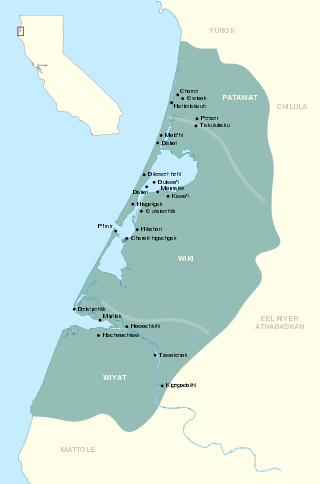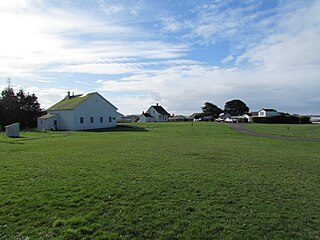Related Research Articles
Lassic also called, Las-sic, Las-Sic, Lasseck and Lassux in various military reports and newspaper articles at the time, was a Wailaki leader during the Bald Hills War.

Camp Lincoln, in Crescent City, California, was a United States military post. It was established June 13, 1862, by the men of Company G, 2nd Regiment, Infantry, California Volunteers to keep peace between the Tolowa tribe of Native Americans and the miners and settlers of northwestern California.

The Wiyot are an indigenous people of California living near Humboldt Bay, California and a small surrounding area. They are culturally similar to the Yurok people. They called themselves simply Ku'wil, meaning "the People". Today, there are approximately 450 Wiyot people. They are enrolled in several federally recognized tribes, such as the Wiyot Tribe, Bear River Band of the Rohnerville Rancheria, Blue Lake Rancheria, and the Cher-Ae Heights Indian Community of the Trinidad Rancheria.

Fort Humboldt State Historic Park is a California state park, located in Eureka, California, United States. Its displays interpret the former U.S. Army fort, which was staffed from 1853–1870, the interactions between European Americans and Native Americans in roughly the same period, logging equipment and local narrow gauge railroad history of the region. Within the collection, there are trains, logging equipment, including a fully functional Steam Donkey engine, and an authentic Native American dug-out canoe. The Fort overlooks Humboldt Bay from atop a bluff. The North Coast regional headquarters of the California State Parks system is located onsite.

The Humboldt Bay Maritime Museum is located in Samoa, California, a small town across Humboldt Bay from Eureka. The focus of the museum is the preservation and interpretation of its collection of artifacts, photographs, library archives and materials which relate principally to the maritime history of California's North Coast. The museum is located in what was the head cook's house next to the Samoa Cookhouse and was founded in 1977.
The Wiyot massacre refers to the incidents on February 26, 1860, at Tuluwat, near Eureka in Humboldt County, California. In coordinated attacks beginning at about 6 am, White settlers murdered 80 to 250 Wiyot people with axes, knives, and guns. The February 26 attacks were followed by similar bloody attacks on other Wiyot villages later that week in what were part of the broader California Genocide.
Albeeville is a former settlement in Klamath County, now located in Humboldt County, California. Albeeville was located on Redwood Creek, within an easy day's travel from Fort Gaston. The post office was named for Joseph Porter Albee, its first postmaster, who was murdered by Indians, and the Albeeville post office burned in November 1863.
Fort Gaston was founded on December 4, 1859, in the redwood forests of the Hoopa Valley, in Northern California, on the west bank of the Trinity River, 14 miles (23 km) from where the Trinity flows into the Klamath River. It was located in what is now the Hoopa Valley Indian Reservation. Fort Gaston as part of the Humboldt Military District was intended to control the Hupa Indians and to protect them from hostile white settlers. The post was named for 2nd Lieutenant William Gaston, of the First Dragoons, who had been killed May 17, 1858, during the Spokane–Coeur d'Alene–Paloos War.

The 2nd Regiment California Volunteer Infantry was an infantry regiment in the Union Army during the American Civil War. It spent its entire term of service in the western United States. Organized at San Francisco and Carson City September 2, 1861, to December 30, 1862, and attached to Department of the Pacific. The regiment was first assembled at the Presidio, San Francisco, and after completing its organization, five companies were sent to Oregon and Washington Territory, to relieve the regular troops, and two companies were sent to Santa Barbara. The troops of this regiment sent to Oregon were afterwards returned to California. It was mustered out during the month of October, 1864.
The 6th Regiment California Volunteer Infantry was an infantry regiment in the Union Army during the American Civil War. It spent its entire term of service in the western United States attached to the Department of the Pacific. The Regiment was organized at Benicia Barracks, San Francisco on February 1, 1863. 6th Regiment mustered out from October 25 to December 20, 1865. The only recorded engagements of the Regiment occurred with the detachment sent to the Humboldt Military District in 1864, near the end of the Bald Hills War. It had engagements with the Indians in the Skirmish at Booth's Run, May 1 and Kneeland's Prairie May 2, near Boynton's Prairie May 6 and at Grouse Creek May 23.

1st Battalion California Volunteer Mountaineers was an infantry battalion in the Union Army during the American Civil War. It spent its entire term of service in the western United States, attached to the Department of the Pacific. It was organized from men from the counties of Humboldt, Mendocino, Trinity, Klamath, Siskiyou, and Del Norte, and other parts of California, between May 30, 1863, and March 16, 1864, for special service in the redwood forests and mountains that was being fought over in the Bald Hills War in Humboldt County within the Humboldt Military District. The Battalion mustered out June 14, 1865.

George Washington Brush was an American soldier, dentist, physician and politician. He served as a captain of a black company in the 34th Infantry Regiment U.S. Colored Troops in the Union Army during the American Civil War and received the Medal of Honor. After the war he became first a dentist and then a physician. He was elected to the New York State Assembly and then the State Senate. As chairman of the Senate Health Committee he helped establish the State Tuberculosis Sanatorium at Saranac Lake.
Elk Camp was an American settlement between Redwood Creek and the Klamath River, fifteen miles northwest of Fort Anderson in modern Humboldt County, California it was formerly located in Klamath County. Elk Camp was a post office from January 31, 1859, to December 19, 1862.
The Keyesville massacre was a mass killing which occurred on April 19, 1863, in Tulare County, California during the Owens Valley Indian War. A mixed force consisting of American settlers and a detachment of the United States Army's 2nd California Cavalry Regiment under Captain Moses A. McLaughlin killed 35 indigenous Californians from the Tübatulabal and Mono peoples "about ten miles from Keysville [sic], upon the right bank of Kern River".

Bald Hills War (1858–1864) was a war fought by the forces of the California Militia, California Volunteers and soldiers of the U.S. Army against the Chilula, Lassik, Hupa, Mattole, Nongatl, Sinkyone, Tsnungwe, Wailaki, Whilkut and Wiyot Native American peoples.

Camp Curtis, California State Historic Landmark #215, was located about one mile north of Arcata, California, and served as the headquarters and garrison of the 1st Battalion California Volunteer Mountaineers from 1862 to 1865.
The 56th United States Colored Infantry was an infantry regiment that served in the Union Army during the American Civil War. The regiment was composed of African American enlisted men commanded by white officers and was authorized by the Bureau of Colored Troops which was created by the United States War Department on May 22, 1863. The regiment was originally organized as the 3rd Arkansas Volunteer Infantry (African Descent) on May 22, 1863.

The 12th Texas Cavalry Regiment was a unit of mounted volunteers recruited in Texas that fought in the Confederate States Army during the American Civil War. The regiment was enrolled in state service in September 1861 and in Confederate service the following month. The regiment fought at Whitney's Lane, Cotton Plant, and L'Anguille Ferry in 1862, Goodrich's Landing in 1863, and Blair's Landing and Yellow Bayou in 1864. The unit also participated in numerous skirmishes and scouts. It disbanded in May 1865.

The 16th Texas Cavalry Regiment was a unit of mounted volunteers from Texas that fought in the Confederate States Army during the American Civil War. The regiment was recruited in early 1862 and mustered into Confederate service in April 1862. The unit fought as cavalry at the Battle of Cotton Plant but it was dismounted in the summer of 1862. The 16th Cavalry served as infantry in Walker's Texas Division for the remainder of the war. The regiment fought at Milliken's Bend, Mansfield, Pleasant Hill, and Jenkins' Ferry. The unit marched to Texas in early 1865 and disbanded in May 1865.
References
- ↑ The War of the Rebellion: A Compilation of the Records of the Union and Confederate Armies. Series I. Vol. L, in Two Parts. Part One -- Reports, Correspondence, Etc. Washington D. C.: Government Printing Office. pp. 67–68.
- 1 2 The War of the Rebellion: A Compilation of the Records of the Union and Confederate Armies. Series I. Vol. L, in Two Parts. Part Two -- Reports, Correspondence, Etc. Washington D. C.: Government Printing Office. First order on page 277. Second order on page 357.
